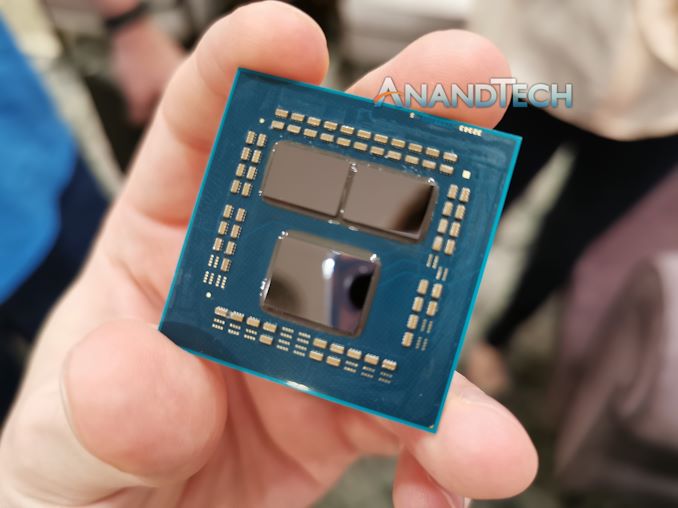Reaching for Turbo: Aligning Perception with AMD’s Frequency Metrics
by Dr. Ian Cutress on September 17, 2019 10:00 AM EST
For those that keep a close eye on consumer hardware, AMD recently has been involved in a minor uproar with some of its most vocal advocates about the newest Ryzen 3000 processors. Some users are reporting turbo frequencies much lower than advertised, and a number of conflicting AMD partner posts have generated a good deal of confusion. AMD has since posted an update identifying an issue and offering a fix, but part of all of this comes down to what turbo means and how AMD processors differ from Intel. We’ve been living on Intel’s definitions of perceived standards for over a decade, so it’s a hard nut to crack if everyone assumes there can be no deviation from what we’re used to. In this article, we’re diving at those perceived norms, to shed some light on how these processors work.
A Bit of Context
Since the launch of Zen 2 and the Ryzen 3000 series, depending on which media outlet you talk to, there has been a peak turbo issue with the new hardware. This turbo frequency issue has been permeating in the ecosystem since Zen 2 was launched, with popular outlets like Gamers Nexus noting that on certain chips, the advertised turbo frequency was only achieved under extreme cooling conditions. For other outlets, being within 50 MHz of the peak turbo frequency has been considered chip-to-chip variation, or a function of early beta firmware. A wide array of people put varying amounts of weight behind this, from conspiracy to not being bothered about it at all.
However, given recent articles by some press, as well as some excellent write-ups by Paul Alcorn over at Tom’s Hardware*, we saw that the assumed public definitions of processor performance actually differs from Intel to AMD. What we used as the default standard definitions, which are based on Intel’s definitions, are not the same under AMD, which is confusing everyone. No one likes a change to the status quo, and even with articles out there offering a great breakdown of what's going on, a lot of the general enthusiast base is still trying to catch up to all of the changes.
This confusion – and the turbo frequency discussion in general – were then brought to the fore of news in the beginning of September 2019. AMD, in a two week span, had several things happen essentially all at once.
- Popular YouTuber der8aur performed a public poll of frequency reporting that had AMD in a very bad light, with some users over 200 MHz down on turbo frequency,
- The company settled for $12.1m in a lawsuit about marketing Bulldozer CPUs,
- Intel made some seriously scathing remarks about AMD performance at a trade show,
- AMD’s Enterprise marketing being comically unaware of how its materials would be interpreted.
Combined with all of the drama that the computing industry can be known for – and the desire for an immediate explanation, even before the full facts were in – made for a historically bad week for AMD. Of course, we’ve reported on some of these issues, such as the lawsuit because they are interesting factoids to share. Others we ignored, such as (4) for a failure to see anything other than an honest mistake given how we know the individuals behind the issues, or the fact that we didn’t report on (3) because it just wasn’t worth drawing attention to it.
What has driven the discussion about peak turbo has come to head because of (1). Der8auer’s public poll, taken from a variety of users with different chips, different motherboards, different cooling solutions, different BIOS versions, still showed a real-world use case of fewer than 6% of 3900X users were able to achieve AMD’s advertised turbo frequency. Any way you slice it, without context, that number sounds bad.
Meanwhile, in between this data coming out and AMD’s eventual response, a couple of contextual discrepancies happened between AMD’s partner employees and experts in the field via forum posts. This greatly exacerbated the issue, particularly among the vocal members of the community. We’ll go into detail on those later.
AMD’s response, on September 10th, was a new version of its firmware, called AGESA 1003-ABBA. This was released along with blog post that detailed that a minor firmware issue was showing 25-50 MHz drop in turbo frequency was now fixed.
Naturally, that doesn’t help users who are down 300 MHz, but it does come down to how much the user understands how AMD’s hardware works. This article is designed to shed some light on the timeline here, as well as how to understand a few nuances of AMD's turbo tech, which are different to what the public has come to understand from Intel’s use of specific terms over the last decade.
*Paul’s articles on this topic are well worth a read:
Ryzen 3000, Not All Cores Are Created Equal
Investigating Intel’s Claims About Ryzen Reliability
Testing the Ryzen 3000 Boost BIOS Fix
This Article
In this article we will cover:
- Intel’s Definition of Turbo
- AMD’s Definition of Turbo
- Why AMD is Binning Differently to Intel, relating to Turbo and OC
- A Timeline of AMD’s Ryzen 3000 Turbo Reporting
- How to Even Detect Turbo Frequencies
- AMD's Fix











144 Comments
View All Comments
Dragonstongue - Tuesday, September 17, 2019 - link
ty so much for the pro article and summing in questionnot always do I come here and "want" to continue reading over...I keep to myself.
thankfully this was not such an article
o7
Iger - Thursday, September 19, 2019 - link
+1This mirrors my thoughts and feelings exactly.
mikato - Monday, September 23, 2019 - link
I completely agree. I had seen some of this with Hardware Unboxed, Gamers Nexus, Der8auer, Reddit. This was a great summary with solid explanation behind it, a more helpful way to learn about the whole issue.Now for the next issue - Hey, Ian is a doctor now, thinks he's better than all of us. Discuss... :)
(yes I knew he had a doctorate already)
azfacea - Tuesday, September 17, 2019 - link
death to intel LULPhynaz - Wednesday, September 18, 2019 - link
Drugs are bad for you, seek treatment.Smell This - Wednesday, September 18, 2019 - link
It sure is interesting that the **Chipzillah Propaganda Machine** has entered high gear/over-drive over the last several weeks after reports that the "Intel Apollo Lake CPUs May Die Sooner Than Expected" ...https://www.tomshardware.com/news/intel-apollo-lak...
Funny that, huh?
eastcoast_pete - Tuesday, September 17, 2019 - link
Thanks Ian, helpful article with good explanations!Question: The "binning by expected lifespan" caught my eye. Could you do another nice backgrounder on how overclocking affects lifespan? I believe many out there believe that there is such a thing as a free lunch. So, how fast does a CPU (or GPU) degrade if it gets pushed (overclocked and overvolted) to the still-usable limit. Maybe Ryan can chime in on the GPU aspect, especially the many "factory overclocked" cards. Thanks!
Ian Cutress - Tuesday, September 17, 2019 - link
I've been speaking to people about this to see if we can get a better understanding about manufacturing as it relates to expected product lifetimes and such. Overclocking would obviously be an extension to that. If something happens and we get some info, I'll write it up.igavus - Tuesday, September 17, 2019 - link
Aside from overclocking, it'd be interesting to know if the expected lifetime is optimized with warranty times and if what we're seeing is a step forward on the planned obsolescence path.It's sort of more important now than ever, because with 8 core being the new norm soon - we'll probably see even longer refresh cycles as workloads catch up to saturate the extra performance available. And limiting product lifetime would help curb those longer than profitable refresh cycles.
FunBunny2 - Tuesday, September 17, 2019 - link
"if what we're seeing is a step forward on the planned obsolescence path."you really, really should get this 57 Plymouth, cause your 56 Dodge has teeny tail fins.